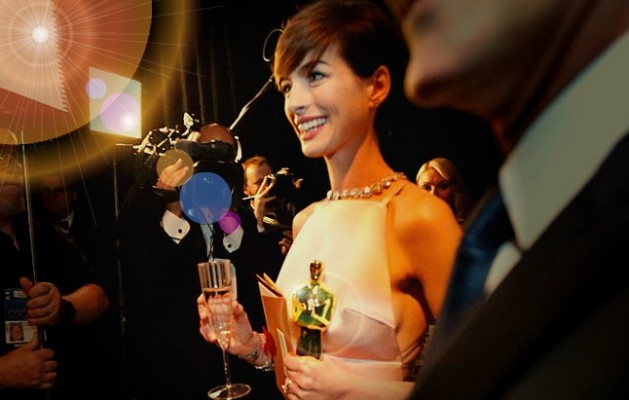Oscar viewing and Oscar parties pretty much go hand in hand these days. In fact, actually watching the Academy Awards ceremony to see who wins has become secondary, an excuse, really, to Oscar partying itself. (Kinda like what the Super Bowl has become—not about the game as about that game that’s in between—in the way of—the commercials). And any Oscar party worth its weight in the form of the gold statuettes being handed out this coming Sunday isn’t really a party unless it has these three key ingredients: an Oscar ballot, passionate partygoers, and the right food and drinks. And as personally as some people take the winning and losing, Oscar viewing, and Oscar parties, have now moved from the privacy of peoples’ living rooms to the openness bars and restaurants. Where more convivially oriented moviegoers can carry on amid their likeminded peers in a celebratory atmosphere. Pretending to care if The Big Short overshadows Spotlight or Leo finally walks off with the guy he should’ve taken home for The Departed (of The Aviator, or What’s Eating Gilbert Grape, or Blood Diamond). While what’s really keeping everyone glued to the tube is Jennifer Lawrence’s photo bombs, Charlize Theron’s hair, Alicia Vikander’s, well, everything.
So. The Oscars. Named for the faceless statue they give out every year, as presented by Hollywood’s Academy of Motion Picture Arts & Sciences, in recognition of the best films of the past year (2015), and the best work done that year by actors, directors, costume designers, writers, and most everyone else involved in making a movie. The Oscar—whose origin no one knows for sure. Kinda like the origins of one of our favorite drinks—the French 75.
Reputedly named for the light artillery gun celebrated by the French in World War I (the French 75mm field gun, aka the 75 and the Soixante-Quinze, and widely used as a truck-mounted anti-aircraft piece), which had been praised by French and American soldiers for its accuracy and quickness, the drink itself supposedly came about via English soldiers who’d been stoically whiling away their boredom and terror in WWI’s French trenches in typically British fashion: What say we take these raw ingredients we have at our disposal, chaps: all that gin and lemon juice and sugar, and, oh, why yes—champagne!—here in the trenches. How clever! Let’s throw it all into that wicked French 75 shell and give a little shake, shall we? Presto, change-o, the French 75 was born.
Unlikely, but entertaining. But the other origin stories are no less mythical: that it was Charles Dickens who created it back during his reading tour of the States in 1867, holding court in his room at Boston’s Parker House with “tom gin and champagne cups. (A champagne cup is bubbly, sugar, citrus, and ice. Throw in the Tom gin and you pretty much have a French 75.) Or it first appeared in 1927, during the height of Prohibition—appearing in a bit of bootlegger’s samizdat called Here’s How! (put out by a New York humor magazine). (It solidified its place among American dipsomaniacs in 1942, when one of the characters, Yvonne, orders a round of French 75s in Casablanca.)
Even the legendary cocktail inventor Harry MacElhone, mixologist extraordinaire and bartender at Harry’s New York Bar, whom many credit as having invented the drink, tried to set the record straight in his 1919 book, Harry’s ABC of Mixing Cocktails, saying it wasn’t he who invented the drink but a bartender named MacGarry of Buck’s Club in London. MacGarry, says MacElhone, basically made a Tom Collins—gin, lemon, sugar, and soda water. Only he’d switched out the soda for champagne.
And so now the debate isn’t so much over the origins of the French 75 as the proper French 75: gin or cognac? (Or vodka? Or even tequila?) Model Kate Moss prefers vodka, which she has dubbed the French 76 and orders liberally at the Hemingway Bar at the Ritz in Paris. “My drink,” she told Playboy, “is the French 76, which is vodka, lemon juice, and sugar topped with champagne. Love! Two of those and you’re like, ‘Oh, life is amazing.”
No matter which way you prefer it, it’s one helluva drink. “The most powerful drink in the world,” according to the late novelist Alec Waugh.
At Santa Fe Spirits, here’s how we make this most powerful drink in the world with a uniquely New Mexican flare:
Ingredients: 2 oz Gruet Brut Sparkling Wine, 1/2 oz lemon juice, 1 oz Wheeler’s Gin, 2 dashes simple syrup
Preparation: Combine gin, syrup, and lemon juice in a cocktail shaker filled with ice. Shake vigorously and strain into an iced champagne glass. Top up with champagne. Stir gently.
Drinkware: Champagne flute
And the Oscar goes to…


